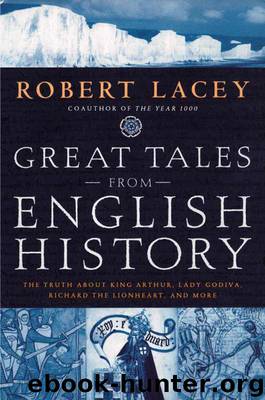Great Tales from English History: The Truth About King Arthur, Lady Godiva, Richard the Lionheart, and More by Lacey Robert

Author:Lacey, Robert [Lacey, Robert]
Language: eng
Format: epub, mobi
Tags: BIO006000
Publisher: Little, Brown and Company
Published: 2004-06-03T04:00:00+00:00
MURDER IN THE CATHEDRAL
AD 1170
KING HENRY II AND HIS CHANCELLOR Thomas Becket were the closest of friends. People declared the two men ‘had but one heart and one mind’. The new Plantagenet king was twenty-one when he came to the throne in 1154. Thomas Becket, a London merchant’s son, was in his mid-thirties, but the difference in their ages and status did not seem to matter. They hunted and played chess together - and both were furious workers. Henry was consumed by the challenge of holding together his diverse and disorderly collection of territories in England and France. Thomas, appointed his chancellor at the start of the reign, was in charge of the royal writing office, drawing up official documents and firing off letters. One clerk later recalled that before taking dictation from Becket he would have to get at least sixty, and sometimes as many as a hundred, quill pens cut and sharpened in advance - he knew there would be no time for sharpening during the session.
Business from all over Henry’s Angevin empire passed through Thomas’s hands, and he revelled in the glory of his position. Imitating his master’s grandfather, Henry I, Thomas kept exotic animals - monkeys, and a couple of wolves that he had trained for hunting their own kind, which still lurked in the royal forests. When he went to France in 1158 to negotiate a marriage treaty for one of Henry’s daughters, he travelled in fabulous luxury.
‘If this be only the Chancellor,’ marvelled onlookers, ‘what must be the glory of the King himself?’
Henry would tease Thomas wryly about his grandeur. As the two men rode together through London one winter’s day, the King saw a poor man shivering in the cold and suggested that he needed a coat. Thomas agreed - whereupon Henry grabbed at his chancellor’s magnificent fur-lined scarlet cloak, and the two friends wrestled together until Thomas gave way.
Henry II was proud of the law and order that he had brought to his so recently chaotic realm. He would refer contemptuously to the reign of his predecessor as the years of ‘disorder’, as if King Stephen had never been. It was in Henry’s reign that the legal status of the jury, first introduced by the Danes, took firm root, and from this time comes the word ‘assizes’, from the Norman French for ‘sitting’. The King’s judges would travel from county to county, sitting in justice over the people to administer the common law - the law that applied to all free men.
The exception was the Church, which had its own courts and a law of its own. If a priest murdered or raped or stole, he could avoid the common-law penalties of hanging or mutilation by claiming ‘benefit of clergy’, the right to be tried in the bishop’s court, which could do no worse than defrock him - expel him from the priesthood - and impose a penance. Common law stopped at the church door, and some clerics were major powers in the land.
Download
Great Tales from English History: The Truth About King Arthur, Lady Godiva, Richard the Lionheart, and More by Lacey Robert.mobi
This site does not store any files on its server. We only index and link to content provided by other sites. Please contact the content providers to delete copyright contents if any and email us, we'll remove relevant links or contents immediately.
In Control (The City Series) by Crystal Serowka(35412)
The Wolf Sea (The Oathsworn Series, Book 2) by Low Robert(33922)
We Ride Upon Sticks by Quan Barry(33358)
Crowbone (The Oathsworn Series, Book 5) by Low Robert(32392)
The Book of Dreams (Saxon Series) by Severin Tim(32299)
The Daughters of Foxcote Manor by Eve Chase(22356)
Trainspotting by Irvine Welsh(20143)
Call Me by Your Name by André Aciman(19064)
Shot Through The Heart (Supernature Book 1) by Edwin James(17964)
The Secret History by Donna Tartt(16766)
The Girl from the Opera House by Nancy Carson(15020)
Sad Girls by Lang Leav(13397)
American King (New Camelot #3) by Sierra Simone(13075)
Pimp by Iceberg Slim(13001)
All the Missing Girls by Megan Miranda(12841)
The Betrayed by Graham Heather(11751)
The Betrayed by David Hosp(11728)
4 3 2 1: A Novel by Paul Auster(11121)
Still Me by Jojo Moyes(9965)
